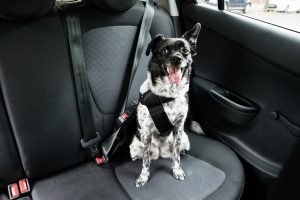Summer is a tough time not only human beings, dogs suffer too. And furry dogs and those with thick coats find it extremely difficult to bear the summer heat. Dogs are prone to heat strokes during the cruel summer months and as responsible dog owners we need to ensure that our pets stay safe and comfortable when the mercury soars.
My black lab, Hotdog suffered a heat stroke a few years back. And it was all because of my ignorance. I had taken him out in the car in the afternoon on a hot April day. Although the car was parked in the shade and I rolled the car windows down, I didn’t know that the car heats up crazily. As we made our way home, Hotdog was bleeding from his nose and I had to rush him to the vet. Fortunately, I got him medical attention at the right time; if I hadn’t, he could have died.
Symptoms of heat stroke in dogs
Heat strokes can happen to dogs very easily in summer. It’s up to you to ensure your dog doesn’t get one. As per www.petmd.com, “Heat stroke…is a form of non-fever hyperthermia that occurs when heat-dissipating mechanisms of the body cannot accommodate excessive external heat. Typically associated with temperature of 106° F (41° C) or higher without signs of inflammation, a heat stroke can lead to multiple organ dysfunction.” Below are the symptoms of heat stroke:
- Heavy panting
- Dizziness
- Weakness
- Bright red tongue
- Bleeding from the nose
- Unconsciousness
- Vomiting
- Thick gluey saliva or excessive salivation/drooling
- Wobbly gait
- Rapid or irregular heartbeat
What do you do if your dog is suffering from a heat stroke?
Well, first and foremost, you need to take immediate action. You need to rush him to your vet. However, in an emergency situation, start treatment at home.
- Your first priority should be to cool your dog right away. What you need to do is to swathe him in a cold, wet towel. You could also dunk him in a bath tub with cool (not ice cold) water, hose him down with a pipe or put an ice pack on his forehead.
- It’s important to ensure that his circulation is maintained. Massage his entire body so that he doesn’t go into shock.
- Give him some cold water to drink if he is conscious. But do not force him.
- However, what is most important is to ensure he gets medical treatment from a vet. You can give him the basic first aid outlined above but if he is severely dehydrated, unconscious or bleeding from the nose, he needs emergency medical treatment, be it intravenous drip or medication. Remember, a heat stroke can be fatal. Don’t try to treat your dog at home; he needs to be checked by a vet.
How to care for your dog in summer
So, how do you prevent your dog from suffering a heat stroke during the searing summer season? Well, it’s quite simple. All you need to do is take good care of your dog and ensure that he is not exposed to severe heat.
Your dog needs to be indoors during the day: That means no leaving him out in a stuffy kennel or chained in the veranda or terrace. Ideally, keep him in an air-conditioned room. However, if your dog is not allowed into the house (a practice I find deplorable), demarcate a cool spot for him on your veranda or in the garden. Make sure he has plenty of water, shade and breeze. You could always place a table fan near him. And NEVER ever leave him on the terrace. It’s not only dangerous because he can suffer a heat stroke; it’s downright cruel.
Your dog needs plenty of water: Just like us, dogs too can get dehydrated during summer. Make sure the water bowl is topped up with water through the day. Dogs love ice; you can give your doggy some ice to chew on. You could also put ice cubes in his water bowl so that the water is cold. Ideally, keep multiple bowls around the house, especially if you are going out. This way, the dog does not run out of water. And, even if he knocks one bowl down or splashes the water from the bowl all around (many puppies especially, do this), there will be an adequate supply of water. If you are taking your dog out – to the vet, for a drive, to the beach or park – carry a collapsible water dish.
Your dog should not be exercised during the day: Yes, your dog still needs to be exercised in summer, but with caution. Take him out early in the morn ing or after sunrise. When the sun is scorching us during the day, dogs start panting and get dehydrated if they are taken out. Also, concrete pavements and graveled roads heat up like crazy. Dogs’ paws are very sensitive; walking them on hot surfaces can cause the paws to burn and even bleed.
ing or after sunrise. When the sun is scorching us during the day, dogs start panting and get dehydrated if they are taken out. Also, concrete pavements and graveled roads heat up like crazy. Dogs’ paws are very sensitive; walking them on hot surfaces can cause the paws to burn and even bleed.
Your dog needs less exercise: My vet always tells me to cut down on exercising my dogs during summer. Dogs tend to get excited when we take them for a walk or play a game of fetch. They don’t know when to stop and this can lead to them getting dehydrated. And in extreme cases, can bring on a heat stroke. We need to be careful. That doesn’t mean you don’t exercise your dog. It just means that you exercise him less.
Your dog should never be left in a car: A dog should never be left unattended in a car in the daytime. The temperature in a parked car can shoot up to 40 -60 degrees Celsius – even when it is parked in the shade and the windows are rolled down. I learnt this the hard way and now, in summer, I never take my dogs out during the day, unless I have to take them to the vet. And I never leave them in a parked car, ever.
I learnt this the hard way and now, in summer, I never take my dogs out during the day, unless I have to take them to the vet. And I never leave them in a parked car, ever.
Ultimately, it all boils down to care. It is up to us as responsible dog owners to ensure that our dogs stay cool and safe in summer. Monitor your dog on hot days; observe him and check for signs of discomfort. If you feel he is hot and bothered, move him to a cooler place. And if he shows any symptoms of heat stroke, rush him to your vet.














































